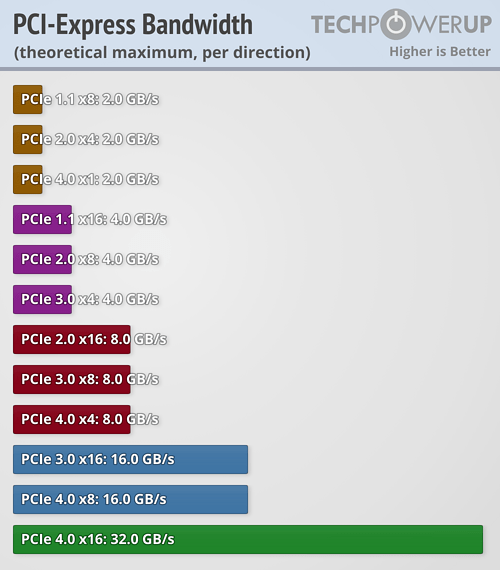 74
74
AMD Radeon RX 6600 XT PCI-Express Scaling
Test Setup »Introduction

In this article, we'll try to understand the performance impact of various PCI-Express configurations for the AMD Radeon RX 6600 XT graphics card. We've been doing PCIe scaling articles for well over a decade: RTX 3080, RX 5700 XT, RTX 2080 Ti, GTX 1080, R9 Fury X, GTX 980, GTX 480, and HD 7870. This kind of article is usually reserved for the topmost-tiered GPUs from AMD and NVIDIA, making this the first time we're evaluating a mid-range GPU from this perspective.
The basis for this article is the fact that the RX 6600 XT, and 7 nm "Navi 23" silicon it's based on, physically only features a PCI-Express 4.0 x8 bus interface. The GPU only has pins for eight PCIe lanes. This was probably a design choice made to cut costs and save pin-count on the compact GPU package. A smaller PCB footprint also makes the GPU desirable for notebook designers looking to hardwire the package directly onto the mainboard, as is the norm these days.

PCI-Express 4.0 x8 is a huge amount of bandwidth. Given that PCIe Gen 4 pushes 16 Gbps per direction, you're looking at 16 GB/s per direction; or at bandwidth that's identical to PCI-Express 3.0 x16. This should be plenty for a mid-range GPU like the RX 6600 XT, end of the story? But wait...there's a catch. When installed on older platforms with PCIe Gen 3, such as Intel 10th Gen "Comet Lake" (or older), or AMD Ryzen 2000 series (or older), the GPU is forced to operate at PCI-Express 3.0 x8, which is half the bandwidth of Gen 4 x8. And if you're on even older platforms, such as AMD FX, however unlikely, it's going to run at PCI-Express 2.0 x8, which is about a quarter of the bandwidth of Gen 4 x8.

The Radeon RX 6600 XT isn't the first time AMD designed a mid-range GPU with x8 PCIe, the RX 5500 XT from the previous RDNA generation also uses PCI-Express 4.0 x8. We didn't much care about this topic back then because those were happier times, when gamers were spoiled for choice with GPUs. In today's unfortunate environment for PC component shoppers, the RX 6600 XT and GeForce RTX 3060 are important parts, as even with scalper pricing, they can be had for around $600, which is somewhat "affordable" to gamers. Among the two, the RX 6600 XT emerged the performance king of the mid-range segment, and so here we are.
In this review, we will test the Radeon RX 6600 XT on various PCI-Express configurations that include native PCI-Express 4.0 x8, PCI-Express 3.0 x8, PCI-Express 2.0 x8, and PCI-Express 1.1 x8. With each older generation, we're effectively halving the bus bandwidth. We switch to the older PCIe generations using the motherboard's UEFI Setup program, and verify with GPU-Z.
Mar 24th, 2025 16:51 EDT
change timezone
Latest GPU Drivers
New Forum Posts
- Is RX 9070 VRAM temperature regular value or hotspot? (158)
- Windows 10 Vs 11, Which one too choose? (69)
- Dune: Awakening benchmark - post your results (40)
- V/F Point window with messed up frequencies (8)
- Is buying a PSU now a bad idea ? (23)
- TPU's Nostalgic Hardware Club (20119)
- RTX 5080 worth it over 5070 TI for 4k? (34)
- Help with Nginx Reverse Proxy (2)
- Thermal testing two different size Gigabyte 5070 Ti cards - huge differences (4)
- The TPU UK Clubhouse (25939)
Popular Reviews
- Assassin's Creed Shadows Performance Benchmark Review - 30 GPUs Compared
- ASUS ProArt X870E-Creator Wi-Fi Review
- ASRock Radeon RX 9070 XT Taichi OC Review - Excellent Cooling
- ASUS GeForce RTX 5070 TUF OC Review
- Sapphire Radeon RX 9070 XT Nitro+ Review - Beating NVIDIA
- AMD Ryzen 9 9950X3D Review - Great for Gaming and Productivity
- Quick Look: Jelly Key Mystic Snake Artisan Keycaps
- AMD Ryzen 7 9800X3D Review - The Best Gaming Processor
- MSI MAG B860 Tomahawk Wi-Fi Review
- ASUS Radeon RX 9070 TUF OC Review
Controversial News Posts
- NVIDIA GeForce RTX 50 Cards Spotted with Missing ROPs, NVIDIA Confirms the Issue, Multiple Vendors Affected (519)
- AMD RDNA 4 and Radeon RX 9070 Series Unveiled: $549 & $599 (260)
- AMD Mentions Sub-$700 Pricing for Radeon RX 9070 GPU Series, Looks Like NV Minus $50 Again (250)
- AMD Radeon RX 9070-series Pricing Leaks Courtesy of MicroCenter (158)
- MSI Doesn't Plan Radeon RX 9000 Series GPUs, Skips AMD RDNA 4 Generation Entirely (142)
- Microsoft Introduces Copilot for Gaming (123)
- AMD Radeon RX 9070 XT Reportedly Outperforms RTX 5080 Through Undervolting (118)
- NVIDIA Reportedly Prepares GeForce RTX 5060 and RTX 5060 Ti Unveil Tomorrow (115)